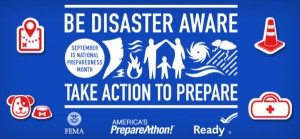Winter hazards can strike before you’re ready. Recently, a raging snowstorm in Buffalo trapped drivers in their cars for 24 hours. Would you be prepared? And last year, the Atlanta metro area was reduced to gridlock by a couple inches of snow. If the roads were impassable, could you survive at home for several days?
Preparing for winter isn’t complicated or expensive. While winter is dangerous, a few simple steps can help you and your family stay safe this season. Here is what NOAA’s National Weather Service (NWS) recommends:
1. Know Your Risk Blizzards, ice storms and freezing temperatures can be a killer for the unprepared. Make sure that you’re aware of the risk that winter brings. Here’s what you need to know:
■A few inches of snow or ice can shut down a city and leave you trapped at home for days.
■Driving on ice and snow-covered roads can lead to car wrecks, injuries and death.
■Snow, ice and wind associated with winter storms can have a huge impact on travel, infrastructure, schools and businesses.
■Some winter storms can cover nearly half the nation, affecting tens of millions of people. Annually, damages from winter storms add up to over $1 billion.
■Frostbite may develop on exposed skin when temperatures are below freezing. Add wind to below freezing temperatures and frostbite can set in even quicker.
■Other winter dangers include hypothermia and avalanches.
■Flooding is also possible due to snowmelt, ice jams and coastal storms such as Nor’easters.
2. Take Action While the weather outside might be frightful, it doesn’t mean that you’re powerless. Prepare for winter with these simple steps:
■Before you go out, check the forecast at weather.gov to make sure you’re prepared for the elements. Follow NWS on Twitter and Facebook to stay up to date with the latest weather news
■At home: have an Emergency Preparedness Kit with three days of food, water, prescription medications and other supplies. Also consider obtaining a NOAA Weather Radio.
■Make sure your cell phone is fully charged when a storm is approaching and also anytime you’re planning to leave the house. It could become your life-line should disaster strike.
■In your car: make sure you have food, water and blankets in your trunk. Stay off the road when advised to do so by local authorities.
■Dress for the season: wear loose, warm clothing in layers.
■Don’t forget your pets! Keep them inside during cold weather.
■During and after the storm: never use a generator or kerosene heater indoors – carbon monoxide poisoning is a silent killer.
■After the storm: take breaks when shoveling snow and stay clear of downed power lines.
3. Be a Force of Nature Being an example works. By sharing your preparedness story, you will inspire others to also prepare for winter. Be a Force of Nature in your hometown:
■Create a Family Communication Plan so that your loved ones know how to get in touch during an emergency.
■Help your neighbors before and after winter storms – especially the elderly, who are particularly vulnerable.
■Look for opportunities to help your town prepare, such as volunteering with the American Red Cross.
■Stay tuned to www.decaturga.com and thedecaturminute.com for up-to-date information.
These simple steps will help keep you safe from blizzards, ice storms and other winter hazards. A little bit of preparation can make a big difference. And many of these steps – such as preparing an Emergency Supplies Kit – will also come in handy for other hazards, such as hurricanes or power outages.


